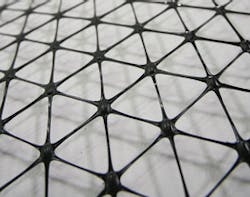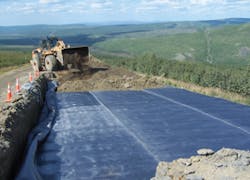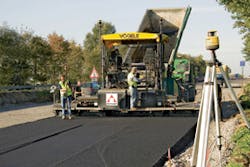In the past, many contractors and local authorities thought the remedy for soft or wet soil conditions was to add more gravel. Unfortunately, the increasing number of vehicles (and, in many cases, heavier vehicles or machines) on the new base soon mixed the new gravel with the wet soil below, and the remedy did not work for long. It’s the long-lasting, durable aspect of roadbuilding that has been helped so much by the use of geosynthetics (or geotextiles, or geogrids). As the qualities of asphalt and concrete have improved, so contractors and owners have learned that excellent materials on top will not make up for poor, unstable materials below the pavement’s surface. That pavement could be a highway, state road, local road, street, parking lot, or anywhere that a good, lasting surface is required. “How long will this last?” is the question asked (for excellent reasons) by many owners and contractors about any recommended improvement in road construction. Every year completed without expensive repairs to a pavement is a blessing for everybody, including us taxpayers.
How does a geotextile (or geosynthetic layer) help? Think of the material as a layer that supports much more than you’d imagine. One of the best comparisons I have seen is to think of a geosynthetic layer as a kind of snowshoe, because it spreads the load of the traffic over a wider area than an ordinary boot or shoe. It is possible, of course, that a lot more gravel on the subsoil may have a similar effect, but the cost of much more gravel would exceed that of a simple geosynthetic solution. There are many names and types of geosynthetic solutions, and they are all best for particular situations, so it would be advisable to contact non-commercial sources of research and manufacturers of different brands to ascertain which type or name of geosynthetic material would be best for your road situations. You could need several different “styles” for different places along the road or highway, but let the manufacturer advise you rather than guessing what would be best.
Rural roads, especially those to visitor centers and tourist spots, can benefit from the stronger sub-base of geosynthetics.
These thoughts on the sub-bases and soil underpavements remind me of the often-repeated, wise advice from the editor of Grading & Excavation Contractor magazine: Know your soil! Learn about the qualities and weaknesses of the soil you are going to move or build on. Everything we build sits on the ground, but that ground varies from country to country, state to state, county to county, even neighborhood to neighborhood. Learn everything you can about the soil where you will be working because, basically, it will control everything you do. How you stabilize that soil will determine how stable your construction will be, whether it’s building or pavement.
Here I will quote a paragraph from one of the most helpful papers I have seen about the use and specifications of geosynthetics for roadbuilding. The paragraph is on Page 17 of a report from Tensar International, world leader in geosynthetic solutions, and was prepared for the enlightenment of design engineers, construction contractors, and owners responsible for either public or private roadway projects in the Americas. The whole report comprises 20 pages. I strongly advise you get a free copy from Tensar in Atlanta, GA.
“Significant resources have been expended over the last 20-plus years to better understand how geogrid properties contribute to the performance of paved and unpaved roadways. Unfortunately, the wide-ranging nature of the products commercially available, combined with the broad spectrum of roadway design variables, has rendered the idea of correlating material properties to a performance parameter a flawed practice. This has been brought to light more so in recent years as new technologically advanced products have become available. These lighter-weight products incorporate unique geometrical profiles that have been proven in full-scale tests to perform significantly better than more well-established, stiffer geogrids produced using the same manufacturing process. The use of a geogrid’s physical and mechanical properties is indeed still necessary. However, the value of these properties is limited to manufacturing quality assurance and quality control. At the present time, the most reliable means by which an engineer can protect the integrity of their particular design is to use a performance specification. The best way to develop such a specification is to base it around the performance benefits demonstrated for a particular product or set of precuts in full-scale pavement test sections.”
The Evidence of Different Applications
Standard road construction equipment manages the geosynthetics
Some 20 years ago, the busy motorway from Dresden to Berlin in Germany (Highway 13) was used for a new method of asphalt resurfacing. The material used was a combination of a stress-absorbing membrane interlayer (SAMI) and a HaTelit asphalt reinforcement grid (from manufacturer Huesker). It was considered a temporary measure, intended to deal with the challenge that concrete and asphalt do not respond in the same way to temperature changes. If there is what we can call a differential movement between the layers, it seems it is usually the asphalt that takes the load. It cracks and the pavement has to be renewed. The HaTelit reinforcement grid greatly reduced this effect; it s-p-r-e-a-d-s the stresses from the concrete into a much larger area of the asphalt. (The method also meant considerable savings for the road authority.) Fifteen years later, a section of the motorway was inspected by engineers from Huesker and the motorway authority. After 15 years of the most unkind traffic, the inspectors detected no significant crack development caused as a result of joint deflection. What began as a “temporary” measure turned out to be a long-term solution. So, yes, geosynthetic modifications and help last very well.
Our interest in geosynthetics here is chiefly for road construction involving asphalt, but we can deduce a good idea of the practical benefits of geosynthetics if we look at some different applications. In Cheyenne, WY, the construction season is not that long and much of the soil is clay, with low shear strength. Making up for the lower resistance of the clay for the West Lincolnway Improvement Project could have required overexcavation to a depth of 16 inches of soft soils and installation of large quantities of base and sub-base material. Two Interstates cross here, I-25 and I-80, and it is a busy location, with many vehicles coming off the Interstates for one reason or another. WYDOT (the Wyoming Department of Transportation) used TriAx Geogrid from Tensar International as part of the value-engineered solution for the project. The general contractor was SEMA Construction, Inc. and, with the geogrid design, they managed to complete the project of rebuilding four lanes and adding a turn lane with greatly reduced overexcavation, removal costs, and materials requirements. WYDOT District 1 resident engineer Don Fuller reported that the switch to TriAx Geogrid reduced the project costs by $148,738. These savings came from the simplification and speed-up of the construction with geosynthetics; the superior performance of the pavement structures; a reduction of the aggregate fill thickness; a decrease in labor and equipment requirements; and a reduction of overexcavation and related removal costs. Not least importantly, the TriAx Geogrid allowed the road construction to proceed even in difficult working conditions.
The problem in Clearfield County, PA, was different. The job is known as the Four Mile Road Subgrade Stabilization Project, and the owner was an oil-and-gas company whose heavy trucks had made the existing access road unsuitable for traffic. The company had been exploring natural-gas formations and were using an unpaved forestry arterial maintained by the Pennsylvania Department of Conservation and Natural Resources (DCNR). The project owner needed an affordable way to restore the unpaved road and support year-round traffic in volumes of up to 1,000 heavy vehicle trips per day. Most of our nation’s gravel or rural roads are unable to bear constantly the weight of those heavy trucks used in everything related to oil and gas activities. In Pennsylvania, geosynthetics showed how the burden could be handled, proof again of the technique’s strength and durability. This wasn’t a 300-yard stretch of road that needed stabilizing; it was 9.5 miles. Apart from the increased traffic, the roads had to accept significant snowfall, “ice lensing,” and soft subgrade soils (with a CBR of 1.0). During the spring thaw, such roads deteriorate quickly. Suggested solutions included putting down soil cement, a new 33-inch-thick aggregate top layer, or a geogrid competitive with Tensar’s geogrids in combination with an aggregate top layer. Those solutions were rejected respectively due to concerns over environmental impact, cost, and performance. The owner chose Tensar TX7 Geogrid. This system allowed the contractor to bridge saturated and crumbling soils by placing the TriAx Geogrid directly on the existing grade. The crews for general contractor Glenn O. Hawbaker Construction repaired the road crown where necessary, then covered all areas of the roadway with TX7 Geogrid and 16 to 30 inches of dense graded aggregate. Reducing the aggregate requirements saved the project owner an estimated $1.2 million in material and installation costs. Explaining the effectiveness of TriAx, David Liporni for Tensar International says: “It has a high-rib profile and a unique hexagonal shape that gives 360-degree load distribution. Its superior base confinement means you can use less aggregate and still bridge wet soil conditions.”
It’s What Is Underneath That Counts
Anybody who has built a road, driveway, street, or even just a garden path knows that the most important part of the construction is not necessarily the type and quality of the top surface but the strength, durability, and stability of what lies beneath. In Rice County, MN, it was swampy ground that presented the challenge. County State Aid Highway 2 (C.S.A.H. 2) required the widening of a 24-foot two-lane paved road. The widening would take the road crest from 24 feet to 42 feet in width and expand the side slopes from 2H:1V to 4H:1V. The roadway crosses two swamp areas, one of 600 feet and the other of 700 feet. When the road was built in the 1960s the swamp areas were only partially excavated to a depth of 10 feet, and then backfilled with clay. A careful investigation noted that the peat extended as much as 45 feet below the existing pavement surface.
Today, you can see some wonderful technology on road construction machines and sites, but you might miss the all-important geosynthetics below.
The peat under the roadway was compressed under the weight of the clay fill, but the peat outside the parameters of the present roadway had a stable crust and plenty of soft peat below. If they put more fill over this soil, it would cause “mudwaving” of the peat during construction. The engineer chose a high-strength geotextile reinforcement plan that included seaming the panels together to maintain continuity. That was to be followed by a stage-loading and surcharge procedure. To meet safety requirements for side slope stability, the designer specified Mirafi HP770PET from TenCate. There are many kinds of geotextiles or geosynthetics; this one is a woven type rather than, say, a honeycomb grid. (You can see why it is so important to get an expert, probably from a manufacturer, to specify the geosynthetic involved in your project rather than guessing at what you think sounds good!) In Minnesota, the Mirafi was cut to length in panels by ParTek Supply, delivered to the project site and then placed with the machine direction of the textile perpendicular to the centerline of the road. The high machine-direction strength of the geotextile helps maintain the integrity of an embankment during construction. The contractor crews had to sew the panels together to maintain good continuity and that was one reason why the engineer did not select a geogrid for the specification. Overlapping would allow the possibility of mud moving up between the panels of material and the engineer required 100% coverage during the operations. Seaming seemed to be the only way to achieve this.
Two rows of stitching, with a two-thread double-locked stitch for security and strength, were made with the seams half an inch apart. The stitching-per-inch setting was set at 4.5 stitches to the inch, based on previous testing. Too few stitches per inch, and the seam sewn might not be strong enough; too many stitches per inch, and the needle holes could weaken the fabric, giving it a kind of zippering or tear along the sewn line. About 6 yards of thread were used for each yard of geotextile sewn. The adjustment in grade of 10 feet was completed over a four-month period to allow excess pore pressures to dissipate within the peat. The high strength geotextile mobilized its strength and the good seams kept the integrity of the fill over the swampy soils.
In Colorado it was a problem caused by soft soils and groundwater when the reconstruction of State Highway 34 (much busier than it sounds!) in Greeley necessitated tearing out the existing roadway section, rebuilding the sub-base, base, and pavement. The Colorado Department of Transportation (CDOT) and Castle Rock Construction Company (CRCC) investigated practical options for a successful completion of the project. CRCC, Bowman Construction Co., and geotextile manufacturer TenCate worked together and proposed Mirafi HP570 for the subgrade stabilization. It’s a high-strength polypropylene. Other options were researched but the use of Mirafi proved to be the most cost-efficient and a sound engineering option. The geotextile was designed to be placed on the subgrade with two feet of Class E road base placed on the fabric. It was the high strength of the fabric and its excellent water flow (30 gallons a minute per square foot) that helped stabilize and consolidate the problem soil and give reinforcement for the roadway section. The fabric was rolled out with appropriate overlaps for the soil conditions and the base material pushed out in front of a loader, spread, and compacted in 1-foot lifts. Here the geosynthetic not only saved material costs, but it also saved the contractor time that might otherwise have been spent waiting for the sub-base to dry and strengthen. It saved the time and expense of unnecessary extra excavation and materials. Once the geotextile-reinforced road was built, the contractor could complete the highway, ahead of schedule and under budget.
The more I read, the more projects I see, the more I understand that a true knowledge of the ground where we are working is essential to successful construction. Checking the properties of the soil and its likely reaction to anything we place on it is vital to a lasting, trouble-free project. When we know what kinds of soil we are going to cover, then we can find out which kind of geosynthetic remedy will work best. It could be a carpet of stitched fabric; it could be a geogrid. We can be sure of one thing. The cost of using the right geotextile (geosynthetic, geogrid) will be much less than hauling and pouring tons of gravel onto the ground in the belief that sheer weight will make everything solid.
Geosynthetic solutions, even in the most public locations, are seldom seen when the project is finished. They are like successful operations for our internal, human ailments; all the evidence from outside may comprise one or two little scars, while the benefits inside are immeasurable. I don’t wish to nag, but it does all start with your good knowledge of the problem terrain. Is it some underlying peat? Is it naturally soft soil with a low shear? Is it little short of a swamp? Is it clay? Or could it be the local climate that attacks and disrupts the soil mercilessly? You need to know, before any project begins.
State and local authorities are looking at geosynthetic solutions as the means to give long-lasting service life to roadways, with lower construction and maintenance costs. A road-widening project for the city of San Diego, CA, started with a test strip. The city used the Spectra Roadway Improvement System, a mechanically stabilized layer that incorporated Tensar’s TriAx Geogrid, to create a test platform. The test compared two TriAx-reinforced sections against a standard, unreinforced section with a thick aggregate base. Experts Southern California Soil & Testing reported that the much thinner TriAx-reinforced sections increased the support modulus of the aggregate base by an average of 125%.
The subgrade at this California site included medium to dense clayey sand with gravel and clayey gravels. The R values along the alignment measured from 26 to 34. The test control section comprised 22 inches of Class II aggregate base with an overlay of 5 inches of asphalt concrete, a type of section used frequently in this region to support flexible pavement sections. The 16-inch-thick test section included one layer of Tensar TX160 Geogrid reinforcement placed 10 inches above the subgrade, while the 14-inch-thick test section included one layer of TX7 Geogrid placed 8 inches above the subgrade. The soil engineers did a series of laboratory and field tests to evaluate the test sections. The tests showed that the two, thinner TriAx Geogrid designs outperformed the unreinforced section with 22 inches of aggregate. “This Spectra System from Tensar also benefits budgets and schedules,” observes Wayne George, general superintendent for the project’s paving contractor, Aspen Construction. “It saves us a lot of time. If you’ve got a big job, TriAx Geogrid makes things go a lot faster.”
In summary, then, using geosynthetics in your paving work can speed the construction while it increases the performance of the paving structures. It can also save huge amounts of aggregate, and that must mean a savings in hauling and material volume. Geosynthetics can also lower your equipment needs and the associated labor costs. It reduces overexcavation with less undercut and, consequently, less removal expense. For some parts of the country, an added and most important benefit is that the use of geosynthetics can allow contractors to continue their construction work despite conditions that might otherwise stop the project temporarily.






